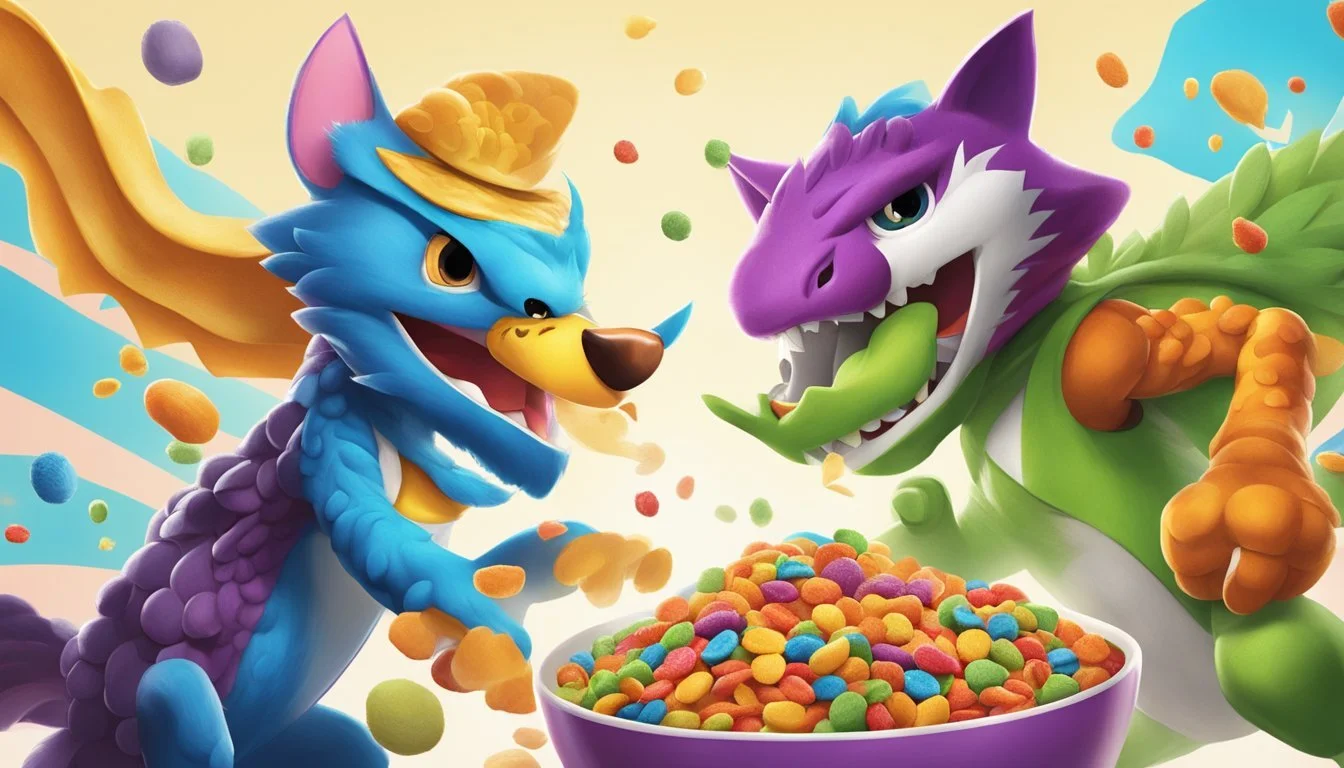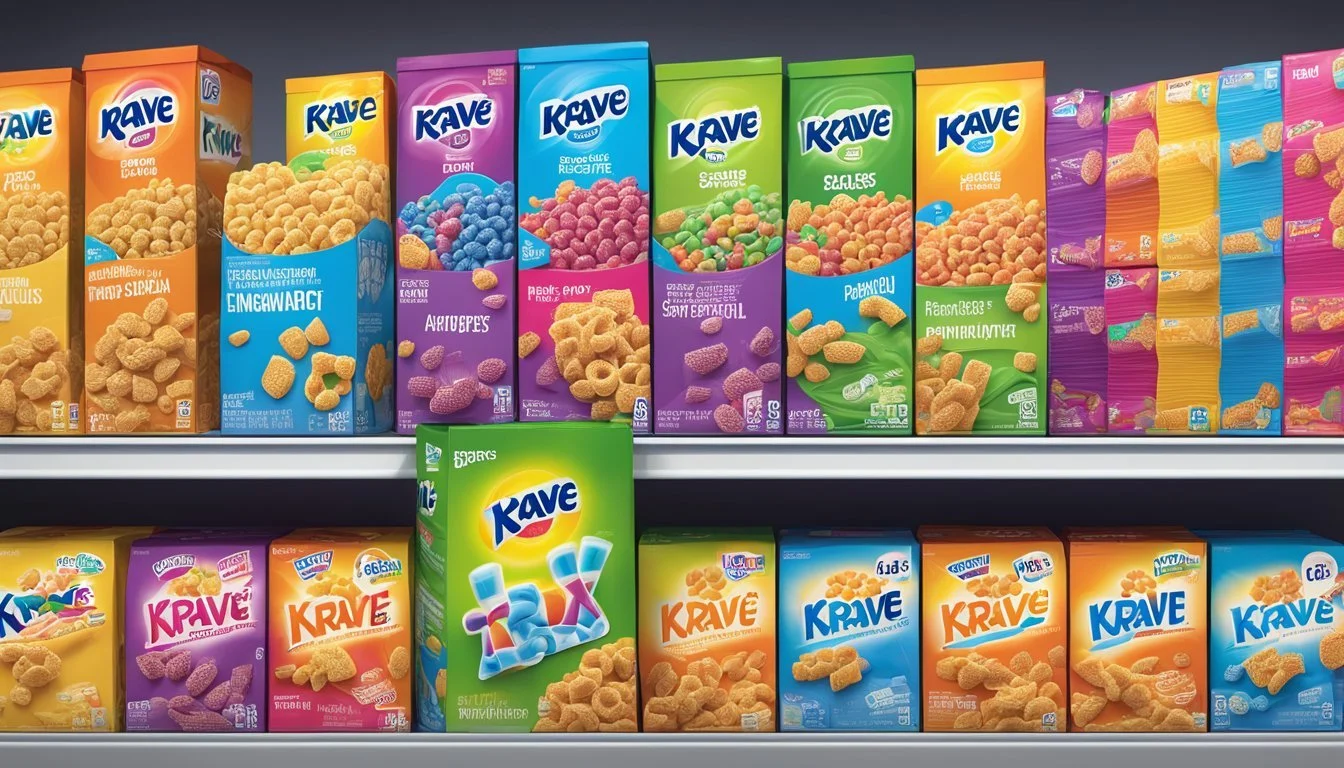Krave vs Trix
Comparing Breakfast Cereals for Taste and Nutrition
This Article is Part of Our Breakfast Cereal Guide with Details on Krave Nutrition and Trix Nutrition
Krave and Trix are two popular cereals that appeal to different tastes but share a common goal: delivering a delightful breakfast experience. Krave, with its chocolate-filled centers, offers a rich, indulgent flavor that can be enjoyed both with milk and as a dry snack. On the other hand, Trix, known for its colorful fruity shapes, provides a burst of sweetness that has captivated children and adults alike for generations.
Krave stands out for its unique combination of a crunchy exterior and creamy interior, reminiscent of soft Milano cookies. This makes it a versatile option for those who enjoy a more dessert-like cereal. Trix, while less complex in its flavor profile, adds a vibrant and playful element to the breakfast table, perfect for anyone seeking a fun start to their day.
Ultimately, the choice between Krave and Trix depends on personal preference. Those who favor chocolaty flavors may lean toward Krave, while those who enjoy a fruity, sugary taste may prefer Trix. Both cereals offer a distinct experience, making them worthy contenders in the cereal aisle.
History and Development
Krave and Trix have both become popular choices in the breakfast cereal market, each with a unique background and journey. The following sections explore the origins of Krave, the evolution of Trix, and the broader context of innovation in breakfast cereals.
Origin of Krave
Krave is a chocolate cereal created by Kellogg's. Its journey began in Israel with a similar product called Kariot.
In 2010, Krave was introduced to the United Kingdom, bringing a new variety to the European cereal portfolio. The product was marketed with catchy slogans like "Taste Unleashed" and "Here Choccy Choccy."
By 2012, its popularity had spread across Europe to countries like France and Germany, eventually reaching the United States. Kellogg's leveraged extensive marketing to build anticipation and appeal for Krave, positioning it as a novel and exciting breakfast option.
The Evolution of Trix
General Mills launched Trix in 1954, bringing vibrant fruity flavors to breakfast tables across America. Originally, Trix was available in three colors and flavors: raspberry red, orange, and lemon yellow.
Over the years, the number of flavors and colors increased, contributing to its widespread appeal.
In 1991, the iconic Trix Rabbit finally tasted a bowl of Trix in a memorable advertising moment. This event marked a significant milestone in the brand's marketing history. Trix has periodically changed its shapes and formulations, adapting to consumer preferences.
Innovation in Breakfast Cereals
The development of innovative cereals has long been a hallmark of the industry. John Harvey Kellogg is credited with creating one of the first ready-to-eat cereals, Granula. This innovation laid the foundation for the diverse cereal market we see today.
Both General Mills and Post have played significant roles in evolving cereal offerings, introducing novel products and marketing strategies.
Krave and Trix exemplify this spirit of innovation. Krave's chocolate-filled pillows and Trix's colorful, fruity shapes highlight the industry's ability to adapt and cater to various taste preferences over time.
Nutritional Profile
Krave and Trix are two popular breakfast cereals, each with their own unique nutritional attributes that can impact daily dietary choices. This section examines the nutrient content of both cereals, highlighting their key components such as vitamins, protein, iron, fiber, and sugar.
Krave's Nutrient Content
Kellogg's Krave cereal is notable for its combination of whole wheat and whole grain flours, making it a source of whole grains. A 53-gram serving of Krave contains 220 calories, which includes 8% fat, 8% sodium, and 15% carbohydrates.
In terms of fat, Krave packs about 4.5 grams of fat per 30-gram serving, with 1.4 grams being saturated fat. Protein content stands at approximately 2 grams per serving.
Sugar is a significant component, with each serving containing 18 grams. This cereal also offers 35% of the Recommended Daily Allowance (RDA) for Iron and substantial amounts of Vitamin B6, making it a relatively nutrient-dense option despite its high sugar content.
Trix Nutritional Information
Trix, a General Mills product, is primarily composed of corn meal as its base. A standard 1-cup serving of Trix provides 120 calories, which includes 1 gram of fat and 10 grams of sugar.
Compared to Krave, Trix has lower fat content and a slightly lower sugar content. It delivers roughly 1 gram of protein per serving and contains minimal fiber at about 1 gram per serving.
Trix also includes various vitamins and minerals, including Vitamin B6 and Iron, although the specific percentages of the RDA can vary depending on the packaging and fortification.
Comparative Vitamin and Mineral Analysis
When comparing Krave and Trix, it's essential to note their differences in vitamins and minerals. Krave contains about 35% of the RDA for Iron and notable amounts of Vitamin B6 due to its whole grain content.
In contrast, Trix provides a smaller percentage of Iron and Vitamin B6. Both cereals are fortified, but Krave’s use of whole grains may give it an edge in terms of natural nutrient content.
The fiber content of Krave is higher due to its whole grain composition, which may be beneficial for digestive health. Trix, while lower in fiber, is still a fortified cereal providing essential vitamins.
Product Varieties and Flavors
Krave and Trix offer diverse and appealing options for cereal enthusiasts with distinct flavor profiles and unique fillings. This section explores the popular variations and how each brand caters to different tastes.
Krave Flavor Portfolio
Krave cereals are known for their rich, indulgent fillings. The core line-up includes:
Chocolate: Semi-hollow, chocolate-striped biscuits with a luscious chocolate center.
Double Chocolate: A combination of chocolate biscuits and a richer chocolate filling.
Chocolate and Strawberry: An option with chocolate biscuits and a sweet strawberry filling, often released for special occasions like Valentine’s Day.
Chocolate and Peanut Butter: A variant that pairs the chocolate biscuits with a creamy peanut butter center.
Krave’s innovative flavors aim to provide a decadent experience, making it a popular choice for those who enjoy a blend of classic and novel tastes.
Trix Varieties Over Time
Trix cereals have seen several transformations throughout the years. They are celebrated for their vibrant colors and fruity flavors:
Original Fruit Shapes: Trix started with fruit-shaped cereals and evolved into round pieces before reverting to the classic shapes due to consumer demand.
Trix Swirls: A variant that mixes two fruity flavors in one puff.
Cocoa Puffs Integration: At times, limited editions incorporate popular flavors like the chocolatey goodness of Cocoa Puffs, blending it with the fruity Trix essence.
Vanilla Creme: A less common flavor that sometimes appears in special editions, offering a twist with a creamy vanilla center.
Trix’s focus on bright, fruity flavors and playful shapes makes it a nostalgic and beloved option among various demographics.
Texture and Taste Experience
Exploring the texture and taste of Krave and Trix cereals offers insights into how each product appeals to different sensory preferences. While Krave is known for its unique filled texture, Trix offers a familiar and nostalgic crunch.
The Appeal of Krave
Krave features a distinct texture with its crispy shell and creamy filling. Each piece has a light texture, which carries a subtle crunch that gives way to a sweet, creamy center.
The center is filled with a vanilla creme that complements the outer chocolate-flavored shell. This combination creates a multi-layered texture experience.
Many find the combination of crispy and creamy pleasing, providing a satisfying contrast that keeps the palate interested. The texture is light, making it easy to enjoy multiple pieces without feeling overwhelmingly indulgent.
Taste Profile of Trix
Trix is renowned for its colorful appearance and fruity flavor. Each piece delivers a consistent crunch, offering a straightforward and satisfying texture that many have enjoyed since childhood.
The taste of Trix can be described as fruity and sweet, using a combination of flavors to create its signature profile.
The crunchiness of Trix cereal pieces lacks the creamy filling seen in Krave, but it appeals to those who prefer a straightforward, nostalgically crunchy cereal. The uniform texture means you can expect the same satisfying crunch with each bite, making it a comforting choice for many.
Cereal Consumption Trends
Eating patterns around cereals have evolved significantly, with growing distinctions between their use as a convenient breakfast and a go-to snack. The nature of cereals has diversified, impacting both their nutritional content and suitability for different times of the day.
Breakfast Versus Snacking
Cereals are traditionally consumed during breakfast. They offer a quick and easy meal, particularly for individuals with busy schedules. Loaded cereals like Cocoa Puffs and Cinnamon Toast Crunch are popular due to their taste, though they often come with higher calories and sugar.
Cereal is also increasingly used as a snack. Many opt for smaller serving sizes throughout the day to curb hunger. Healthier options with lower sugar and higher fiber content are favored for snacking. High-fiber cereals contain at least 74% wholewheat and low salt, suitable for both breakfast and snack.
The Role of Cereals in a Healthy Breakfast
A healthy breakfast often balances carbohydrates, protein, and fiber. To cater to health-conscious consumers, companies have reformulated cereals to reduce sugar and fat. For example, non-HFSS variants from Kellogg's Wheats range are low in fat and high in fiber.
Understanding serving sizes is key. Many brands indicate nutrition per serving to guide healthier consumption. Cereal brands like Krave and Trix vary in nutritional value, and awareness can help one choose better options. Selecting cereals rich in antioxidants and complex carbohydrates supports a balanced, nutritious start to the day.
Marketing and Consumer Perception
Krave and Trix employ distinct marketing strategies to influence consumer perceptions, utilizing a blend of advertising tactics, branding, and market positioning.
Advertising Strategies
Krave and Trix leverage diverse advertising platforms to reach their target audiences.
Krave, produced by Post, typically uses modern, edgy advertisements aimed at appealing to an older demographic, including teenagers and young adults.
Their campaigns often highlight the indulgent and rich chocolate flavor, setting the cereal apart from traditional breakfast options.
In contrast, Trix, made by General Mills, focuses on vivid, playful advertisements primarily targeting children.
Their commercials are characterized by bright, energetic themes and the catchphrase, "Silly rabbit, Trix are for kids!"
This playful branding creates a sense of fun and excitement, aligning with children's preferences.
Branding and Mascots
Mascots play a crucial role in the branding of both cereals.
Krave’s branding features a more mature, sleek aesthetic that emphasizes the cereal's chocolate-filled centers.
While Krave does not have a central mascot, it often depicts animated cereal pieces engaging in amusing antics, appealing to a slightly older audience than Trix.
Trix's branding heavily relies on its mascot, the Trix Rabbit, an enduring character that has been central to the brand for decades.
The Trix Rabbit’s constant, humorous attempts to steal the cereal add a whimsical narrative that reinforces brand identity and connects emotionally with young consumers.
Market Positioning
The market positioning of Krave and Trix differs significantly.
Krave positions itself as a unique and indulgent treat within the cereal market, suitable for both breakfast and snacking purposes.
Its marketing often highlights the risk of missing out on the rich taste experience, tapping into the appeal of indulgence and novelty.
Trix, on the other hand, is positioned firmly within the children’s cereal segment.
By emphasizing bright colors, fruity flavors, and fun, its marketing strategies foster a strong appeal among children.
Trix’s positioning leverages nostalgia among parents familiar with the brand from their own childhoods, bridging generational gaps.
Both Krave and Trix effectively utilize strategic marketing to influence consumer perceptions, tailored to their respective target markets.
Health Considerations
When comparing Krave and Trix cereals, it's essential to examine several health factors. These include their sugar content, fat and additives levels, and their overall contribution to a balanced diet. Each of these factors impacts wellness in different ways.
Sugar Content and Its Implications
Both Krave and Trix cereals are known for their high sugar content. Krave contains a smooth, sugary chocolate center and is marketed as a chocolate flavored cereal. Trix, on the other hand, is colorful and fruity, but also high in sugar and artificial additives.
Krave:
Contains 18 grams of sugar per serving.
Offers the taste appeal of chocolate, which makes it a hit among kids and adults.
Trix:
Known for its bright colors and fun shapes.
Contains high amounts of sugar, which contributes to potential weight gain and metabolic issues.
High sugar intake is linked to increased risk of obesity, type 2 diabetes, and dental problems. Reducing sugar consumption is critical for maintaining good health.
The Debate on Fats and Additives
Fats and additives play a significant role in the nutritional profile of cereals. Krave contains both whole wheat and whole grain flours, but also hydrogenated oils which are concerning. Trix is noted for its artificial additives and colorings.
Krave:
Contains moderate fat content, primarily from chocolate and added oils.
Hydrogenated oils can contribute to an increased risk of heart disease.
Provides a modest amount of protein and fiber, beneficial for fullness and digestion.
Trix:
Low in fat but high in artificial additives.
Additives and colorings are linked to hyperactivity in children and other health risks.
Practically no fiber content, which is essential for digestive health.
Understanding the types of fats and additives is crucial, as some can have adverse health effects.
Cereal and Dietary Balance
Balancing cereals within a diet involves considering their contributions to daily nutritional needs. Krave offers a moderate amount of fiber and protein, while Trix falls short in these areas.
Krave:
Provides 3.7 grams of fiber per 100 grams.
Serves as a better option in terms of whole grains and dietary fiber.
Contains essential vitamins and minerals, such as iron and zinc, contributing to overall nutrition.
Trix:
Lacks significant fiber content, leading to shorter satiety.
The low fiber content means it does not support digestive health effectively.
High in simple carbohydrates from sugar, which can cause energy spikes and crashes.
Incorporating cereals that blend better macronutrient profiles can aid in creating balanced diets, especially for school-aged children and busy adults.
Consumption Habits
Consumption habits for Krave and Trix cereals vary significantly in terms of serving sizes and the ways they are enjoyed by consumers. Understanding these habits can help you make more informed decisions about your breakfast or snack choices.
Serving Sizes and Frequency
Krave's suggested serving size is 53 grams, providing 220 calories per serving. It's typically consumed by those craving a chocolate-filled breakfast. Trix, on the other hand, offers a standard 31-gram serving size, yielding around 120 calories.
Krave consumers are often adults or teens seeking a richer, chocolaty experience. They might enjoy it occasionally due to its higher calorie content. Trix is a favorite among children, often eaten more regularly because of its fun, fruity flavors and lower caloric density.
In both cases, serving sizes are often adjusted based on individual preferences. Some might combine the cereals with banana slices or add more milk for a fuller meal, while others enjoy it dry as a quick snack.
Cereal as a Meal or Treat
Krave tends to be enjoyed more as a treat, given its higher sugar content and chocolate center. Consumers with a sweet tooth might indulge in it as a dessert rather than a breakfast staple. Its iron and vitamin B6 content, however, adds nutritional value to those treating it as a meal.
Trix, with its bright colors and fun marketing, mostly appeals to young children who eat it as a breakfast cereal alongside milk. Parents often choose Trix for its lower calorie content, making it a more frequent snack option as well. Its sugar content also positions it as a treat, particularly with younger age groups.
Both cereals, Krave and Trix, show differing consumption patterns based on their nutritional profiles and target demographics. While Krave is seen as an occasional indulgence, Trix fits easily into regular meal routines.
Comparative Analysis
This section looks at how Krave and Trix cereals perform in different markets globally as well as the preferences consumers have regarding these two popular cereals.
Krave vs Trix in Various Markets
Krave and Trix cereals have penetrated different markets globally, each with varying levels of success. Krave is known for its chocolate-filled squares, which appeal particularly to younger consumers and those with a sweet tooth. In markets like Europe, Krave has seen strong sales due to its indulgent flavor profile and unique product offering. It performs well in regions that favor rich, dessert-like breakfast options.
On the other hand, Trix, with its fruity flavors and vibrant colors, appeals largely to children and families. It has a long-standing presence, especially in the American market. Trix's branding and marketing strategies often involve playful and nostalgic elements, making it a favorite in households looking for something fun and colorful.
In global markets, both cereals compete fiercely. Krave often targets the segment interested in new and innovative cereal concepts, while Trix maintains its classic charm to attract loyal customers.
Consumer Preferences
Consumer preferences for Krave and Trix differ significantly. Krave tends to attract those looking for a cereal that doubles as a snack. Its chocolate filling and crunchy texture make it suitable for all-day consumption, not just breakfast. This versatility increases its appeal in diverse consumer segments.
Trix, known for its fruity taste and bright colors, resonates with consumers who prefer a traditional, fun, and visually appealing breakfast cereal. Many families favor Trix for its kid-friendly image and the nostalgic value it brings to parents who grew up eating it.
Consumers in European markets often prefer Krave due to the rich flavors, while in American and other global markets, Trix holds a competitive edge with its vibrant appeal and established brand loyalty.
Future of Breakfast Cereals
The breakfast cereal market is rapidly evolving with a focus on innovation and shifting consumer values like health and sustainability. Key industry players like General Mills and Post are leading the charge.
Innovations on the Horizon
Cereal companies are continuously introducing new products, blending traditional flavors with innovative ingredients. General Mills’ Loaded line is one such example, featuring cereals with a vanilla creme center that can be enjoyed as breakfast or a snack.
These innovations aim to attract a variety of consumers, from kids seeking fun flavors to adults looking for convenience and taste. Healthier options featuring more protein, fiber, and less sugar are also gaining traction, driven by consumer demand for nutritious breakfast choices.
Shifting Consumer Values
Consumers are increasingly prioritizing health and sustainability. There's a growing trend towards cereals with functional ingredients such as antioxidants, probiotics, and whole grains. Brands are responding by reducing sugar content and focusing on clean labels.
Additionally, sustainable practices in production and packaging are important. Companies like Post and General Mills are adopting eco-friendly packaging and sourcing practices to meet environmentally conscious customer expectations. These shifts reflect a broader cultural movement towards healthier, more sustainable food options.










